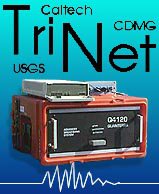SCE Contacts: Steve Conroy/Tom Boyd
(626) 302-2255
World Wide Web Address: http://www.sce.com
Caltech Contact: Max Benavidez
(626) 395-3226
World Wide Web Address: http://www.caltech.edu/~media
[email protected]
ROSEMEAD, Calif., Jan. 15, 1999—On the eve of the fifth anniversary of the devastating Northridge earthquake, Southern California Edison and the California Institute of Technology today announced the utility's participation in a state-of-the-art seismic measuring network that will expedite power restoration and emergency response after a major temblor in the southland.
As a participant in the TriNet Project, SCE will use a portion of its system of nearly 900 electrical substations to augment TriNet's growing network. Seismic sensoring devices, installed at selected substations, will be linked directly to TriNet through SCE's extensive communications network, which is built to withstand severe earthquakes.
When complete, TriNet will consist of nearly 600 monitoring stations in Southern California with the capability to provide faster information on where the most damaging shaking has occurred when earthquakes strike. SCE will be able to use that information to prioritize the dispatch of repair crews and accelerate service restoration efforts to areas suffering the most damage.
"Following an earthquake, good, accurate information is a precious commodity," said Stephen E. Frank, SCE president and chief operating officer, at a press conference today. "Good information can save time, money, and—most importantly—lives. We're excited about the potential benefits of TriNet, and as the largest electric utility in the region, we feel Edison is in a unique position to add value to the TriNet effort." Within 10 minutes of an event, TriNet will produce preliminary map information. Within 30 minutes, more detailed maps showing shaking intensity will be produced. The "shake maps" will give authorities an accurate indication of where utilities and authorities should concentrate recovery efforts.
Dick Rosenblum, SCE senior vice president for transmission & distribution, said TriNet will help the utility assess problems more quickly at the utility's nearly 900 electrical substations spread over a 50,000-square-mile area.
"By getting useful information in a matter of minutes, we can dispatch crews to where we know the greatest shaking and damage has occurred," said Rosenblum. "We knew fairly quickly where the Northridge earthquake was centered, but it was hours before we knew the degree of damage that—miles away and outside the San Fernando Valley—Santa Monica had experienced."
Paul Jennings, Caltech's acting vice president for business and finance, and a professor of civil engineering and applied mechanics, said, "The TriNet Project is a wonderful example of a public/private partnership, where different organizations come together, leverage their resources, and together create a product no one organization could create alone. Edison's investment will significantly move this project forward and help provide Southern California with a state-of-the-art seismic network."
SCE currently has installed TriNet monitoring units at substations in Rosemead, Palmdale, Hesperia, Mira Loma, and White Water. Another 25 substations will have the monitoring equipment installed within the next 18 months.
SCE also announced today it will provide $250,000 over five years for TriNet, with each dollar matched by a $3 contribution from the Federal Emergency Management Administration (FEMA) and the California Office of Emergency Services.
FEMA is funding 75 percent of the nearly $17-million TriNet Project. Caltech's commitment to the effort is being funded by SCE, GTE, Pacific Bell, the Times Mirror Foundation, and others. The U.S. Geological Survey has provided more than $4 million. The California Division of Mines and Geology is another participant.
An Edison International company, Southern California Edison is the nation's second largest investor-owned electric utility, serving more than 11 million people in a 50,000-square-mile area within central, coastal and Southern California.




